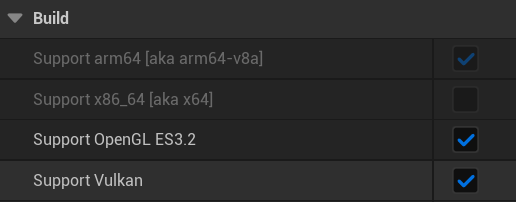The Unreal Engine developer documentation contains most of what you'll need to use Unreal Engine to target Android devices.
Getting started
The Android Quick Start guide covers most of what you'll need to begin Android development, including:
- Creating a mobile project
- Configuring the project to target Android
- Setting up the editor for mobile renderer previews
- Launching on an Android target device
- Packaging your Android build into an APK for testing
If you're using Windows as your development platform, Unreal integrates with the Android Game Development Extension for Visual Studio.
Packaging your project
The Packaging Android Projects guide not only covers packaging your Android build into an APK file, it also covers getting your build ready for distribution using Android App Bundle.
Play Asset Delivery
The Google Play Asset Delivery reference covers how to enable Play Asset Delivery in your project, how to designate rules to create asset chunks that will become asset packs in the Android App Bundle, and how to take advantage of install-time, fast-follow, and on-demand assets.
Play Integrity API
Play Integrity API helps you check that your game is unmodified, installed by Google Play, and running on either a genuine Android-powered device or a genuine instance of Google Play Games for PC. Your game's backend server can respond when you detect risky traffic to prevent unauthorized access and cheating. Refer to the documentation and Runtime API reference on how to integrate this feature with the Unreal Engine plugin.
Play In-app Updates
Play In-app Updates lets you prompt users to update to the latest version of your game, when a new version is available, without the user needing to visit the Play Store. Refer to the documentation and Runtime API reference on how to integrate this feature with the Unreal Engine plugin.
Play In-app Reviews
Play In-app Reviews lets you prompt users to submit Play Store ratings and reviews without leaving your game. Refer to the documentation and Runtime API reference on how to integrate this feature with the Unreal Engine plugin.
Google Play Billing
The In-app Purchases guide covers how to configure your game for Google Play's billing system, how to read purchase information, and how to make purchases.
Vulkan API
Vulkan is a cross-platform, high-performance 3D graphics API that has low overhead compared with OpenGL ES.
To enable the Vulkan graphics API, navigate to Project Settings > Platforms > Android > Build and select Support Vulkan. When you select both Support Vulkan and Support OpenGL ES3.2, Unreal uses Vulkan by default. If the device doesn't support Vulkan, Unreal falls back to OpenGL ES 3.2.

Frame pacing
Unreal 4.25 and higher integrates the Android Frame Pacing Library, which is part of the Android Game Development Kit. The Mobile Frame Pacing article explains how to enable the Android Frame Pacing Library, and how to control frame pacing from C++ code.
Rendering optimization
The Rendering Optimization for Mobile guide covers guidelines and best practices for optimizing mobile performance, including when to use normal maps versus high-vertex meshes. It covers the basics for reducing draw calls, mesh count and material ID count, as well as material complexity, optimizing texture resolution, boot time, and package size.
Best practices
We also have best practice articles around art assets, identity, distribution, and more that will help you as you navigate the Android ecosystem with Unreal Engine.
16 KB page support
A page is the granularity at which an operating system manages memory. To improve the operating system performance overall and to give device manufacturers an option to make this trade-off, Android 15 (API level 35) and higher can run with 4 KB or 16 KB page sizes. Devices configured with 16 KB page sizes use slightly more memory on average but also gain various performance improvements.
Unreal 5.6 and higher support 16 KB page sizes.
